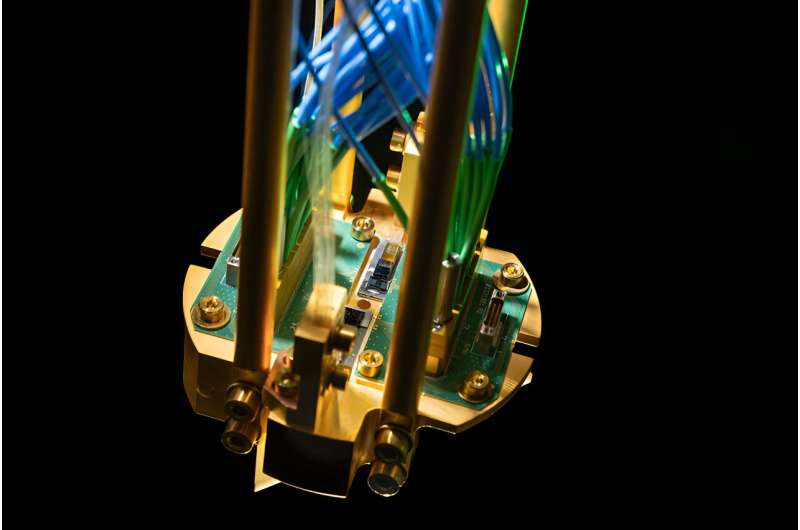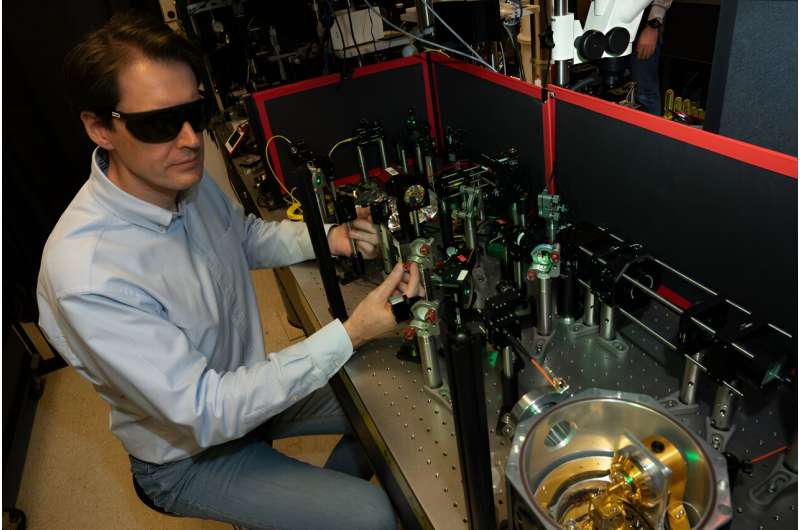This article has been reviewed according to Science X's editorial process and policies. Editors have highlighted the following attributes while ensuring the content's credibility:
fact-checked
peer-reviewed publication
trusted source
proofread
Quantum repeaters use defects in diamond to interconnect quantum systems

The popular children's game of telephone is based on a simple premise: The starting player whispers a message into the ear of the next player. That second player then passes along the message to the third person and so on until the message reaches the final recipient, who relays it to the group aloud. Often, what the first person said and the last person heard are laughably different; the information gets garbled along the chain.
Such transmission errors from start to end point are also common in the quantum world. As quantum information bits, or qubits (the analogs of classical bits in traditional digital electronics), make their way over a channel, their quantum states can degrade or be lost entirely. Such decoherence is especially common over longer and longer distances because qubits—whether existing as particles of light (photons), electrons, atoms, or other forms—are inherently fragile, governed by the laws of quantum physics, or the physics of very small objects.
At this tiny scale (nanoscale), even slight interactions with their environment can cause qubits to lose their quantum properties and alter the information they store. Like the game of telephone, the original and received messages may not be the same.
"One of the big challenges in quantum networking is how to effectively move these delicate quantum states between multiple quantum systems," says Scott Hamilton, leader of MIT Lincoln Laboratory's Optical and Quantum Communications Technology Group, part of the Communications Systems R&D area. "That's a question we're actively exploring in our group."
As Hamilton explains, today's quantum computing chips contain on the order of 100 qubits. But thousands, if not billions, of qubits are required to make a fully functioning quantum computer, which promises to unlock unprecedented computational power for applications ranging from artificial intelligence and cybersecurity to health care and manufacturing. Interconnecting the chips to make one big computer may provide a viable path forward.
On the sensing front, connecting quantum sensors to share quantum information may enable new capabilities and performance gains beyond those of an individual sensor. For example, a shared quantum reference between multiple sensors could be used to more precisely locate radio-frequency emission sources.
Space and defense agencies are also interested in interconnecting quantum sensors separated by long ranges for satellite-based position, navigation, and timing systems or atomic clock networks between satellites. For communications, quantum satellites could be used as part of a quantum network architecture connecting local ground-based stations, creating a truly global quantum internet.
However, quantum systems can't be interconnected with existing technology. The communication systems used today to transmit information across a network and connect devices rely on detectors that measure bits and amplifiers that copy bits. These technologies do not work in a quantum network because qubits cannot be measured or copied without destroying the quantum state; qubits exist in a superposition of states between zero and one, as opposed to classical bits, which are in a set state of either zero (off) or one (on).
Therefore, researchers have been trying to develop the quantum equivalents of classical amplifiers to overcome transmission and interconnection loss. These equivalents are known as quantum repeaters, and they work similarly in concept to amplifiers, dividing the transmission distance into smaller, more manageable segments to lessen losses.
"Quantum repeaters are a critical technology for quantum networks to successfully send information over lossy links," Hamilton says. "But nobody has made a fully functional quantum repeater yet."
The complexity lies in how quantum repeaters operate. Rather than employing a simple "copy and paste," as classical repeaters do, quantum repeaters work by leveraging a strange quantum phenomenon called entanglement. In quantum entanglement, two particles become strongly connected and correlated across space, no matter the distance between them. If you know the state of one particle in an entangled pair, then you automatically know the state of the other.
Entangled qubits can serve as a resource for quantum teleportation, in which quantum information is sent between distant systems without moving actual particles; the information vanishes at one location and reappears at another. Teleportation skips the physical journey along fiber-optic cables and therefore eliminates the associated risk of information loss. Quantum repeaters are what tie everything together: they enable the end-to-end generation of quantum entanglement, and, ultimately, with quantum teleportation, the end-to-end transmission of qubits.

Ben Dixon, a researcher in the Optical and Quantum Communications Technology Group, explains how the process works. "First, you need to generate pairs of specific entangled qubits (called Bell states) and transmit them in different directions across the network link to two separate quantum repeaters, which capture and store these qubits. One of the quantum repeaters then does a two-qubit measurement between the transmitted and stored qubit and an arbitrary qubit that we want to send across the link in order to interconnect the remote quantum systems.
"The measurement results are communicated to the quantum repeater at the other end of the link; the repeater uses these results to turn the stored Bell state qubit into the arbitrary qubit. Lastly, the repeater can send the arbitrary qubit into the quantum system, thereby linking the two remote quantum systems."
To retain the entangled states, the quantum repeater needs a way to store them—in essence, a memory. In 2020, collaborators at Harvard University demonstrated holding a qubit in a single silicon atom (trapped between two empty spaces left behind by removing two carbon atoms) in diamond. This silicon "vacancy" center in diamond is an attractive quantum memory option.
Like other individual electrons, the outermost (valence) electron on the silicon atom can point either up or down, similar to a bar magnet with north and south poles. The direction that the electron points is known as its spin, and the two possible spin states, spin up or spin down, are akin to the ones and zeros used by computers to represent, process, and store information. Moreover, silicon's valence electron can be manipulated with visible light to transfer and store a photonic qubit in the electron spin state.
The Harvard researchers did exactly this; they patterned an optical waveguide (a structure that guides light in a desired direction) surrounded by a nanophotonic optical cavity to have a photon strongly interact with the silicon atom and impart its quantum state onto that atom. Collaborators at MIT then showed this basic functionality could work with multiple waveguides; they patterned eight waveguides and successfully generated silicon vacancies inside them all.
Lincoln Laboratory has since been applying quantum engineering to create a quantum memory module equipped with additional capabilities to operate as a quantum repeater. This engineering effort includes on-site custom diamond growth (with the Quantum Information and Integrated Nanosystems Group); the development of a scalable silicon-nanophotonics interposer (a chip that merges photonic and electronic functionalities) to control the silicon-vacancy qubit; and integration and packaging of the components into a system that can be cooled to the cryogenic temperatures needed for long-term memory storage. The current system has two memory modules, each capable of holding eight optical qubits.
The group has published two articles on their research, one in Physical Review Applied and one in Nature Materials.
To test the technologies, the team has been leveraging an optical-fiber test bed leased by the laboratory. This test bed features a 50-kilometer-long telecommunications network fiber currently connecting three nodes: Lincoln Laboratory to MIT campus and MIT campus to Harvard. Local industrial partners can also tap into this fiber as part of the Boston-Area Quantum Network (BARQNET). The network is described in an article posted to the arXiv preprint server.
"Our goal is to take state-of-the-art research done by our academic partners and transform it into something we can bring outside the lab to test over real channels with real loss," Hamilton says. "All of this infrastructure is critical for doing baseline experiments to get entanglement onto a fiber system and move it between various parties."
Using this test bed, the team, in collaboration with MIT and Harvard researchers, became the first in the world to demonstrate a quantum interaction with a nanophotonic quantum memory across a deployed telecommunications fiber. With the quantum repeater located at Harvard, they sent photons encoded with quantum states from the laboratory, across the fiber, and interfaced them with the silicon-vacancy quantum memory that captured and stored the transmitted quantum states. They measured the electron on the silicon atom to determine how well the quantum states were transferred to the silicon atom's spin-up or spin-down position.
"We looked at our test bed performance for the relevant quantum repeater metrics of distance, efficiency (loss error), fidelity, and scalability and found that we achieved best or near-best for all these metrics, compared to other leading efforts around the world," Dixon says.
"Our distance is longer than anybody else has shown; our efficiency is decent, and we think we can further improve it by optimizing some of our test bed components; the read-out qubit from memory matches the qubit we sent with 87.5% fidelity; and diamond has an inherent lithographic patterning scalability in which you can imagine putting thousands of qubits onto one small chip."
The Lincoln Laboratory team is now focusing on combining multiple quantum memories at each node and incorporating additional nodes into the quantum network test bed. Such advances will enable the team to explore quantum networking protocols at a system level. They also look forward to materials science investigations that their Harvard and MIT collaborators are pursuing. These investigations may identify other types of atoms in diamond capable of operating at slightly warmer temperatures for more practical operation.
More information: David J. Starling et al, Fully Packaged Multichannel Cryogenic Quantum Memory Module, Physical Review Applied (2023). DOI: 10.1103/PhysRevApplied.19.064028
Madison Sutula et al, Large-scale optical characterization of solid-state quantum emitters, Nature Materials (2023). DOI: 10.1038/s41563-023-01644-8
Eric Bersin et al, Development of a Boston-area 50-km fiber quantum network testbed, arXiv (2023). DOI: 10.48550/arxiv.2307.15696
Journal information: Nature Materials , arXiv
Provided by Massachusetts Institute of Technology
This story is republished courtesy of MIT News (web.mit.edu/newsoffice/), a popular site that covers news about MIT research, innovation and teaching.





















